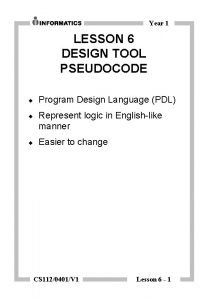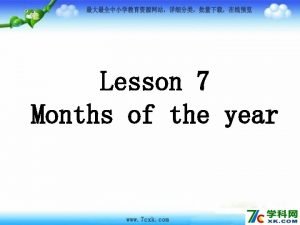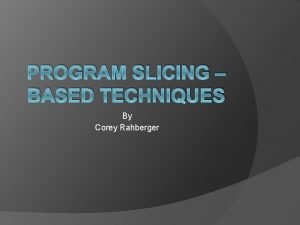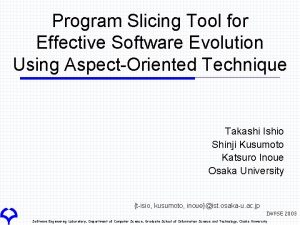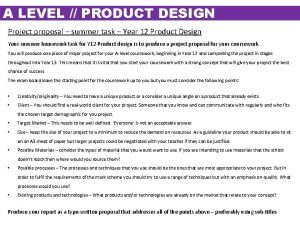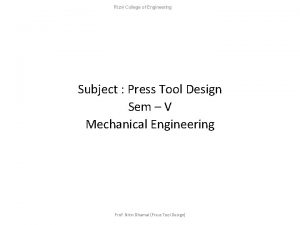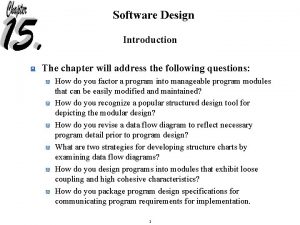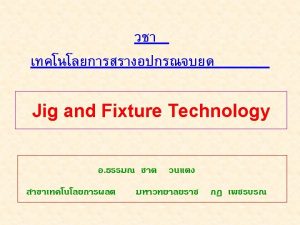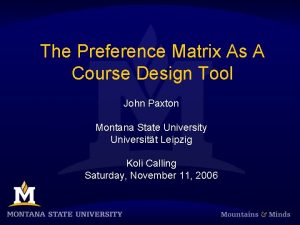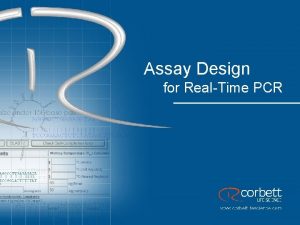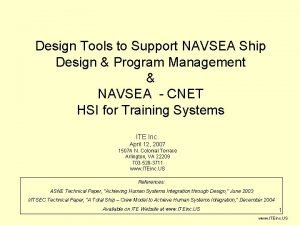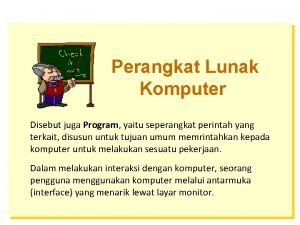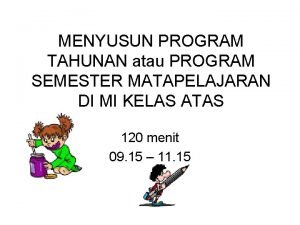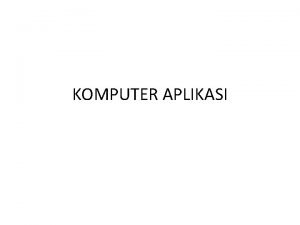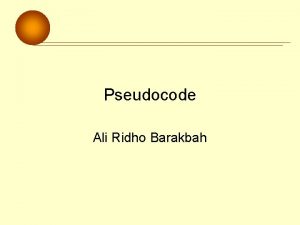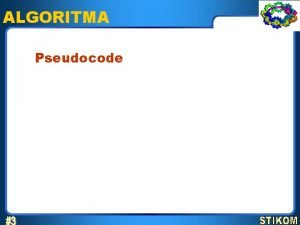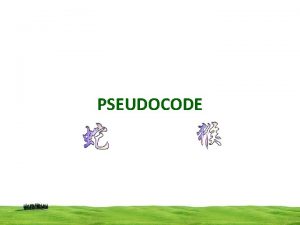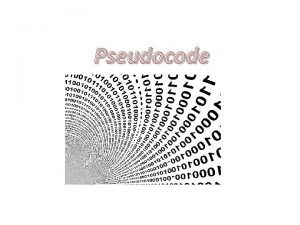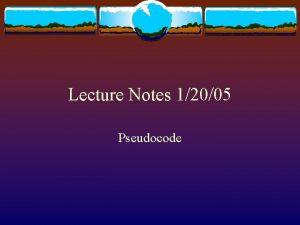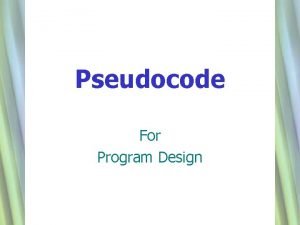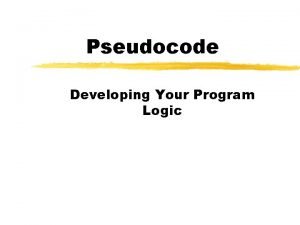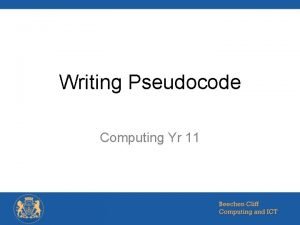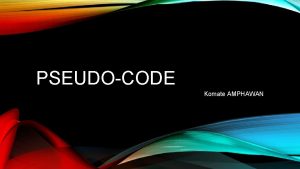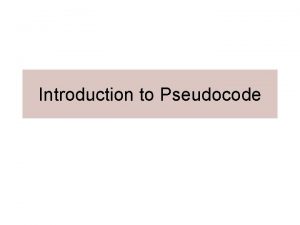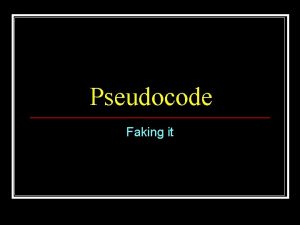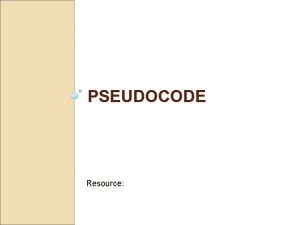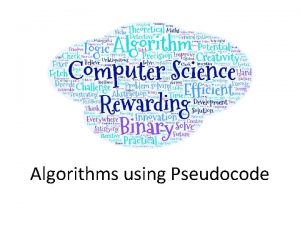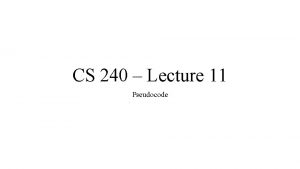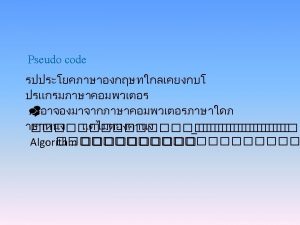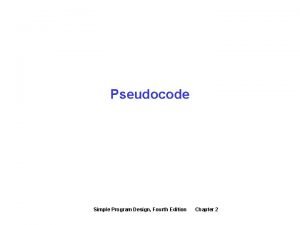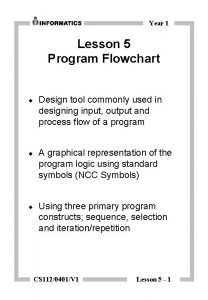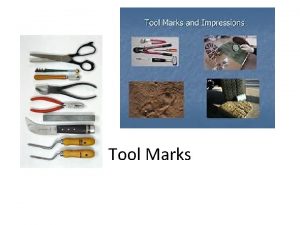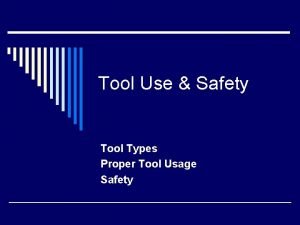Year 1 LESSON 6 DESIGN TOOL PSEUDOCODE Program






















- Slides: 22

Year 1 LESSON 6 DESIGN TOOL PSEUDOCODE ¨ Program Design Language (PDL) ¨ Represent logic in English-like manner ¨ Easier to change CS 112/0401/V 1 Lesson 6 - 1

Year 1 Rules for Pseudocode ¨ Language independent ¨ Indentation for readability ¨ Key words in capital letters ¨ Punctuation optional ¨ IF ends with ENDIF ¨ Ends DO, DO WHILE, DO FOR with ENDDO ¨ Main routine shown first CS 112/0401/V 1 Lesson 6 - 2

Year 1 Advantage of Pseudocode ¨ Bridges gap between human language & computer language ¨ Logic expressed in straightforward way ¨ Easy to understand ¨ Good design tool ¨ Easier to make changes ¨ Allow structured walkthroughs CS 112/0401/V 1 Lesson 6 - 3

Year 1 SEQUENCE/SELECTION CS 112/0401/V 1 Lesson 6 - 4

Year 1 SELECTION CS 112/0401/V 1 Lesson 6 - 5

Year 1 SELECTION (CASE) CS 112/0401/V 1 Lesson 6 - 6

Year 1 SELECTION (CASE) DO CASE CHOICE-A DO MOD-E ENDDO CHOICE-B DO MOD-F ENDDO CHOICE-C DO MOD-G ENDDO CHOICE-D DO MOD-H ENDDO ENDCASE CS 112/0401/V 1 Lesson 6 - 7

Year 1 ITERATION CS 112/0401/V 1 Lesson 6 - 8

Year 1 PSEUDOCODE ¨ The three basic program constructs · Sequence · Selection · Iteration CS 112/0401/V 1 Lesson 6 - 9

Year 1 PSEUDOCODE ¨ Sequence · A series of statements (instructions) · Pseudocode convention – READ – WRITE – ACCEPT – DISPLAY – PRINT – INPUT – GET · Consistent use of conventions throughout pseudocode CS 112/0401/V 1 Lesson 6 - 10

Year 1 PSEUDOCODE ¨ Pseudocode convention Comments Statements that are non-executable Indication: /*…*/ e. g. /* Comment aids legibility */ e. g. /* This is an example of a long comment */ CS 112/0401/V 1 Lesson 6 - 11

Year 1 PSEUDOCODE ¨ Pseudocode Convention · Iteration: REPEAT…UNTIL To repeat a given set of commands Condition is checked after actions REPEAT commands UNTIL condition e. g. REPEAT ACCEPT number cube number ** 3 DISPLAY number, cube UNTIL number = 0 CS 112/0401/V 1 Lesson 6 - 12

Year 1 PSEUDOCODE ¨ Pseudocode Convention · Do not use equal sign in assignment statements. · Use in assignment statements or words ‘set to’ · Use ‘=‘ sign only in conditional statements. CS 112/0401/V 1 Lesson 6 - 13

Year 1 PSEUDOCODE ¨ Pseudocode Convention · Iteration: FOR loop For fixed number of iterations FOR index IN RANGE min TO max DO commands ENDDO e. g. FOR I IN RANGE 1 to 10 DO PRINT I, I**2 ENDDO CS 112/0401/V 1 Lesson 6 - 14

Year 1 PSEUDOCODE ¨ Pseudocode Convention · Selection: IF…THEN Carry or ignore commands based on condition IF condition THEN commands ENDIF /* simple condition */ e. g. IF marks > 90 THEN class ‘First’ ENDIF CS 112/0401/V 1 Lesson 6 - 15

Year 1 PSEUDOCODE /* compound condition */ e. g. IF marks >= 80 and marks <= 90 THEN class ‘Second’ ENDIF CS 112/0401/V 1 Lesson 6 - 16

Year 1 PSEUDOCODE ¨ Pseudocode Convention · IF-THEN-ELSE…ENDIF To select one of two or more alternative commands depending on a given condition IF condition THEN command sequence 1 ELSE command sequence 2 ENDIF e. g. IF marks >= 50 THEN remarks ‘Pass’ ELSE remarks ‘Fail’ ENDIF CS 112/0401/V 1 Lesson 6 - 17

Year 1 PSEUDOCODE ¨ Pseudocode Convention · Multi-way selection Further extension of IF-THEN-ELSE construct to allow multiple selection IF condition 1 THEN command sequence 1 ELSE IF condition 2 THEN command sequence 2 ELSE IF condition 3 THEN command sequence 3 ENDIF (indentation for easy reading) CS 112/0401/V 1 Lesson 6 - 18

Year 1 PSEUDOCODE ¨ Pseudocode Convention · Selection: Multi-way selection CASE…ENDCASE DO CASE of index CASE index condition 1 command sequence 1 CASE index condition 2 command sequence 2 CASE index condition 3 command sequence 3 OTHERWISE command sequence ENDCASE CS 112/0401/V 1 Lesson 6 - 19

Year 1 PSEUDOCODE ¨ Pseudocode Convention Selection: Multi-way / selection CASE…ENDCASE e. g. DO CASE OF menu_choice CASE ‘E’ DO enquiry routine ENDDO CASE ‘U’ DO update routine ENDDO CASE ‘X’ EXIT menu ENDDO OTHERWISE DISPLAY error message ENDCASE · CS 112/0401/V 1 Lesson 6 - 20

Year 1 PSEUDOCODE Exercises 1. Write a pseudocode segment that reads 3 numbers A, B and C and display the biggest value of the three numbers. CS 112/0401/V 1 Lesson 6 - 21

Year 1 PSEUDOCODE Exercises 2. Write a pseudocode segment for a program that calculates the BONUS on a salesman’s sale. Zero if SALES is less than $2000 Ten percent of SALES if amount is between $2000 to $4000 Five percent of SALES plus $1000 if amount is $4000 or above CS 112/0401/V 1 Lesson 6 - 22
 Pseudocode convention
Pseudocode convention Year 6 leaving poem
Year 6 leaving poem Potter's tool is data cleaning tool
Potter's tool is data cleaning tool Child development chapter 9
Child development chapter 9 Mangoes round the year lesson plan
Mangoes round the year lesson plan Months of the year
Months of the year Aaron rahberger
Aaron rahberger Program sustainability assessment tool
Program sustainability assessment tool Jkeyword planner
Jkeyword planner Year 13 product design projects
Year 13 product design projects Press tool design
Press tool design Primary tool used in structured design is
Primary tool used in structured design is Objectives of tool design
Objectives of tool design Course design tool
Course design tool Structured analysis approach
Structured analysis approach Rt pcr primer efficiency
Rt pcr primer efficiency Ship design tool
Ship design tool Differences between sequential and event-driven programming
Differences between sequential and event-driven programming Sebuah program komputer disebut
Sebuah program komputer disebut Menyusun program tahunan dan program semester
Menyusun program tahunan dan program semester Microsoft excel merupakan program aplikasi?
Microsoft excel merupakan program aplikasi? Lembar kerja program aplikasi pengolah angka adalah ...
Lembar kerja program aplikasi pengolah angka adalah ... Memulai microsoft word
Memulai microsoft word
